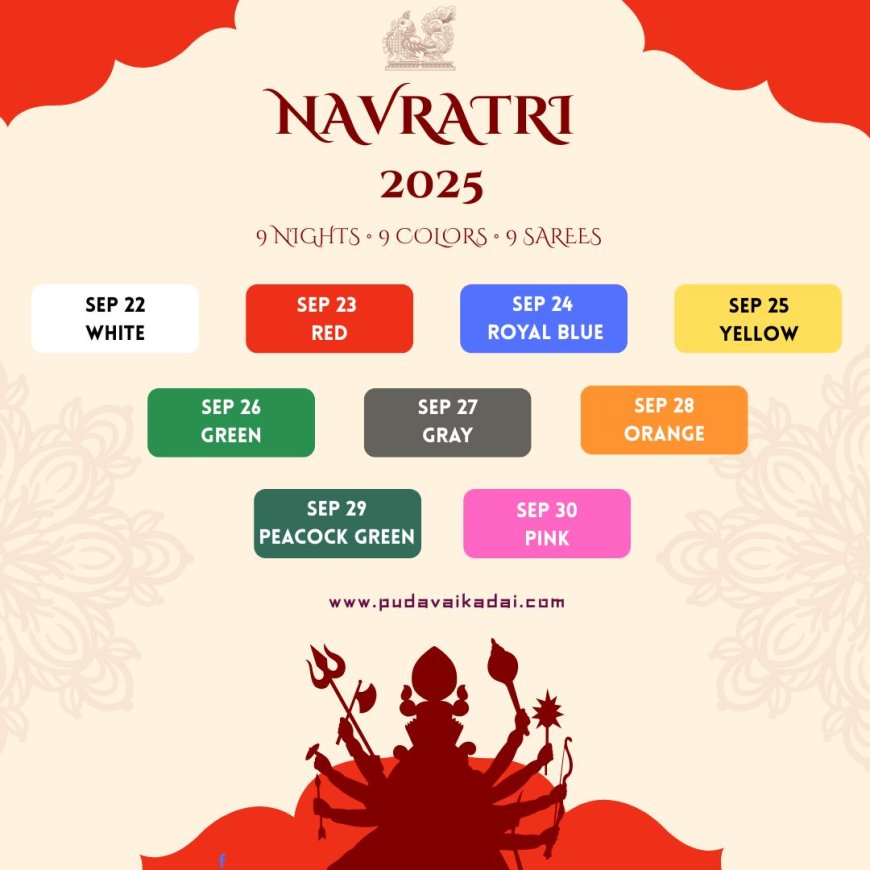Navratri Colours 2025 Full List of 9 Colours of Navratri, Their Significance and Which Goddess to Worship on Each Day
Navratri Colours 2025 guide: 9 days, 9 colours, their meanings & goddesses to worship. Celebrate with devotion, rituals & spiritual significance.

Introduction
Navratri, one of the most celebrated Hindu festivals, is a nine-day spiritual journey dedicated to Goddess Durga and her nine divine forms, also known as Navadurga. The festival is not only about devotion but also about discipline, cultural traditions, and spiritual cleansing. Each of the nine days of Navratri is associated with a specific colour, representing unique qualities, energies, and the goddess to be worshipped. Wearing these colours is considered auspicious and symbolizes aligning oneself with divine blessings.
History & Importance of Navratri
Navratri, which literally means "nine nights," finds its origins in ancient Hindu scriptures such as the Devi Mahatmya and Markandeya Purana. It symbolizes the victory of good over evil, with Goddess Durga defeating the demon Mahishasura after nine days of intense battle. The festival is celebrated across India with unique traditions—Durga Puja in Bengal, Garba and Dandiya in Gujarat, and Golu arrangements in Tamil Nadu.
How Many Days Navratri is Celebrated?
Navratri is observed for nine days and nights, each day dedicated to a different avatar of Goddess Durga. On the tenth day, Vijayadashami (Dussehra) is celebrated, marking the triumph of dharma (righteousness) over adharma (evil).
Navratri Colours 2025: Day-Wise List, Significance, and Goddesses
- Day 1 – Orange (Shailaputri)
-
-
Goddess: Shailaputri, daughter of the Himalayas.
-
Significance: Symbolizes energy, enthusiasm, and new beginnings.
-
Why Wear: Brings strength and positivity to start the festival.
-
-
Day 2 – White (Brahmacharini)
-
Goddess: Brahmacharini, goddess of wisdom and meditation.
-
Significance: Stands for peace, purity, and calmness.
-
Why Wear: Encourages discipline and devotion.
-
-
Day 3 – Red (Chandraghanta)
-
Goddess: Chandraghanta, the warrior form.
-
Significance: Symbol of courage and fearlessness.
-
Why Wear: To gain strength and ward off negativity.
-
-
Day 4 – Royal Blue (Kushmanda)
-
Goddess: Kushmanda, creator of the universe.
-
Significance: Represents prosperity and good health.
-
Why Wear: Invites growth and abundance.
-
-
Day 5 – Yellow (Skandamata)
-
Goddess: Skandamata, mother of Kartikeya.
-
Significance: Symbolizes happiness and positivity.
-
Why Wear: For blessings of motherhood, joy, and harmony.
-
-
Day 6 – Green (Katyayani)
-
Goddess: Katyayani, the fierce warrior goddess.
-
Significance: Represents fertility, growth, and courage.
-
Why Wear: For strength and overcoming obstacles.
-
-
Day 7 – Grey (Kalaratri)
-
Goddess: Kalaratri, the destroyer of darkness.
-
Significance: Symbolizes power and protection.
-
Why Wear: To remove ignorance and evil forces.
-
-
Day 8 – Purple (Mahagauri)
-
Goddess: Mahagauri, symbol of purity and forgiveness.
-
Significance: Represents dignity, beauty, and spirituality.
-
Why Wear: For inner peace and blessings of wisdom.
-
-
Day 9 – Peacock Green (Siddhidatri)
-
Goddess: Siddhidatri, granter of supernatural powers.
-
Significance: Symbolizes accomplishment and divine grace.
-
Why Wear: To receive spiritual knowledge and ultimate success.
-
Key Points
-
Nine Days, Nine Colours: Each day has spiritual and psychological effects, harmonizing energies.
-
Cultural Unity: Though celebrated differently across regions, colours unite devotees under one tradition.
-
Spiritual Cleansing: Wearing the right colour symbolizes surrender to divine power.
Drawbacks & Challenges
-
Over-commercialization of Navratri sometimes overshadows its spiritual essence.
-
Many people focus more on fashion and events rather than the deeper significance.
-
Excessive crowding and pollution during Garba, Durga Puja, or idol immersions pose environmental concerns.
Advantages & Positives
-
Strengthens spiritual connection with the divine.
-
Encourages discipline, fasting, and healthy eating.
-
Promotes cultural togetherness and unity.
-
Colours psychologically uplift mood and energy levels.
Latest Updates & Buzz
In 2025, many temples and online platforms are promoting eco-friendly celebrations and live-streaming of Navratri pujas. Social media campaigns are spreading awareness about the significance of colours and how wearing them can align with cosmic vibrations.
Final Thoughts & Conclusion
Navratri 2025, with its unique set of nine colours, is more than just a festive ritual—it is a spiritual journey of discipline, devotion, and cultural pride. Each colour represents a unique energy that connects us with the divine mother. While there may be drawbacks like commercialization and environmental issues, the advantages outweigh them when celebrated with sincerity and eco-consciousness.
By embracing the colours of Navratri and worshipping the respective goddess each day, devotees not only honor tradition but also invite positivity, strength, and prosperity into their lives.
✨ In essence, Navratri is a celebration of energy, courage, and spiritual awakening—expressed beautifully through nine powerful colours.

 Ellofacts
Ellofacts 





